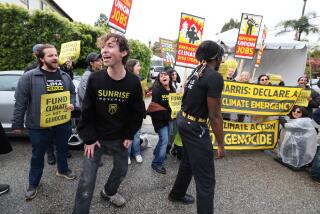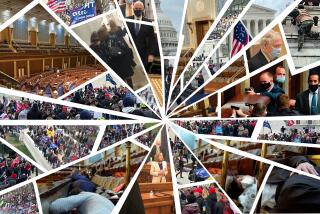‘Safe,’ Though Smelly, Senate Offices Reopen
- Share via
WASHINGTON — When Dianne Feinstein’s staff walked back into their third-floor suite Tuesday morning, it was as though time had stood still. The calendars were turned to Oct. 17, the day the California Democrat and 49 of her colleagues were evacuated from the Hart Senate Office Building in the throes of an anthrax attack.
The fax machine had spent weeks spitting out a mountain of missives that no one was there to read, finally sputtering to a stop when the paper ran out. A wooden wall of shoebox-sized slots was stuffed with correspondence three months old. Five hundred fifty e-mails had amassed in one staffer’s computer. Most of the plants were dead.
“The only thing that kept moving was the clocks,” said Jim Hock, Feinstein’s press secretary. He studied a curious residue on a piece of paper that sat on a desk during the cleanup, which was ordered after a letter laced with anthrax was opened in the office of Senate Majority Leader Tom Daschle (D-S.D.).
Tuesday’s return marked a passage for Washington as the million-square-foot complex reopened for business, a testament to the resiliency of a federal government that endured a terrible autumn.
When the doors closed that October day, no one imagined it would be for so long. Thirteen Senate offices were ultimately deemed contaminated in an attack in which deadly spores were sent through the U.S. mail, killing five people across the East.
Left behind in the rush to get out were senators’ briefcases, computer files, personal checkbooks and half-empty cups of coffee. The Washington work force that serves half the U.S. Senate was abruptly displaced, flung all over the Capitol complex. Republicans lent space to Democrats, and vice versa. Workers made do with borrowed computers and not enough phones. Some wondered whether life here would ever feel normal again.
“Wooo-hoooo!” rejoiced Michele Hall, communications director for Sen. Tom Harkin (D-Iowa), as she walked back in, a trolley of boxes, files and a roll of wrapping paper in tow. “I cannot put into words how good it is to be back. It feels like going into the dorms after summer vacation--except it smells a lot like a swimming pool.”
The smell was unmistakably abnormal, and people sniffed the air as they cleared the security X-ray machines, endeavoring to describe it.
“It smells like bleach,” said one.
“Like a new plastic toy.”
“It’s that new car smell.”
It might have been the remains of the chlorine dioxide gas used to decontaminate the place, or maybe the thorough scrubbing delivered this weekend by work crews trying to restore a building weeks in hibernation. Whatever it was, it was giving some people a headache and others a sore throat, and some aides said they were less concerned about the anthrax than the stuff used to kill it.
“You know anthrax is a strong bacteria, so what took it out had to be strong too,” said Dan Kunsman, press secretary to Sen. Craig Thomas (R-Wyo.). Kunsman returned to the office to find a 12-week-old apple and banana that looked nothing like they did.
Officials from the Environmental Protection Agency and the Centers for Disease Control and Prevention declared the building “safe and clean,” although they would not go as far as to say it was “risk-free.”
“Extraordinary measures have been taken using the safest technology available to us . . . for the lowest possible risk that can be achieved,” Dr. Patrick Meehan of the CDC said at a news conference. “But as with any public health problem, we cannot eliminate any risk entirely.”
Still, the staffers came back. Daschle said he knew of no one in the Hart building’s 5,000-member work force to resign out of safety concerns. But a twinge of ambivalence was in evidence.
Sen. Joseph I. Lieberman (D-Conn.) said he was going in “with confidence and a prayer.”
Sen. Harry Reid (D-Nev.) led his office entourage into the building in a demonstration of his good faith, however measured. “It feels fine. This is good for government,” he said, adding later, “I think we are all waiting for the next shoe to drop.”
The worker sentiment was probably best described by the ebullient Hall, who whooped for joy to be back herself but had no intention of letting her children visit any time soon: “They are 5 and 7, and they were concerned about me going back. I told them I felt safe--but I won’t be bringing them back here for a long, long, long time.”
The building’s reopening was delayed several times, most recently last week when a bag with gloves and a protective suit--left behind by the cleanup crew--was discovered above a hallway ceiling outside the Daschle suite, prompting another flurry of precautions. The delay made Tuesday’s homecoming all the sweeter.
“So this is a great day. It’s good to be back,” Daschle said. “It’s good to be confident that we can return to normalcy. And it is good that the Senate is working again with all eight cylinders.”
Daschle made the pronouncement at noon as he officially reclaimed the building but not his infected office. Stripped of all furniture, the walls knocked down, it is free of spores but will take weeks to rebuild.
After 45 minutes inside, a lot of people said they felt as though they had never left. The phones started ringing again. The cafeteria churned out chili.
But the day-to-day rituals remained small reminders that something is different. Hall’s job description now includes opening the mail, a task now deemed too dangerous for a volunteer or an intern like the one who opened the Daschle letter Oct. 15. “My job went from mundane to life-threatening overnight,” she said.
Because of the building’s closure, Sen. Orrin G. Hatch (R-Utah) lost two plants he was given at the funerals of his parents years ago. The palms that graced the building’s sun-splashed atrium also died of thirst. The California flag in Feinstein’s conference room is an odd yellow now; her aides wonder whether it’s from the gas. And just last week they received Christmas invitations that were not only late but discolored and brittle from post office irradiation.
More to Read
Sign up for Essential California
The most important California stories and recommendations in your inbox every morning.
You may occasionally receive promotional content from the Los Angeles Times.













